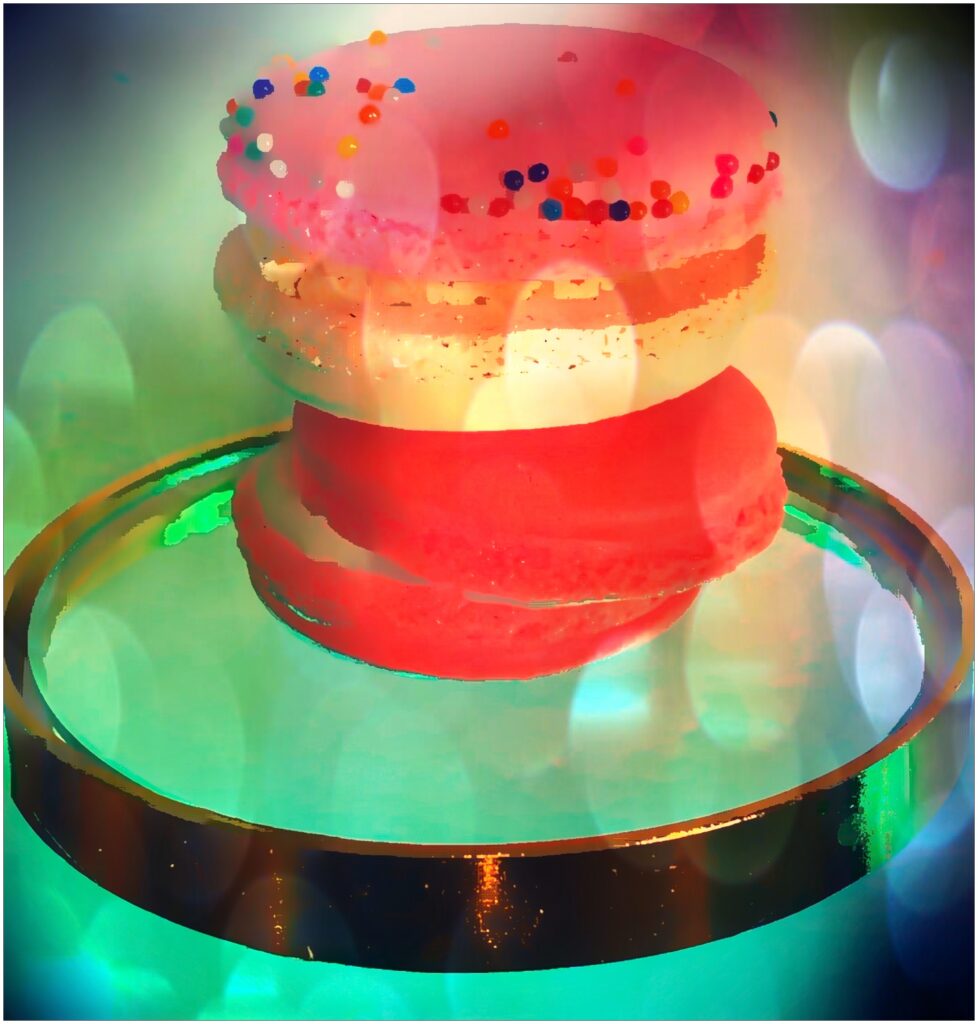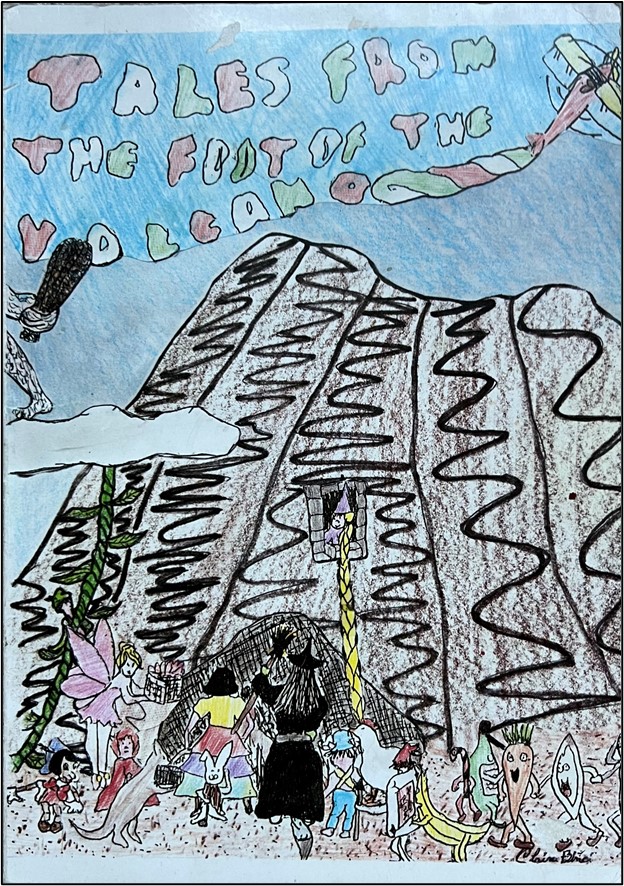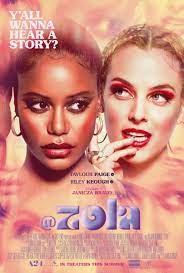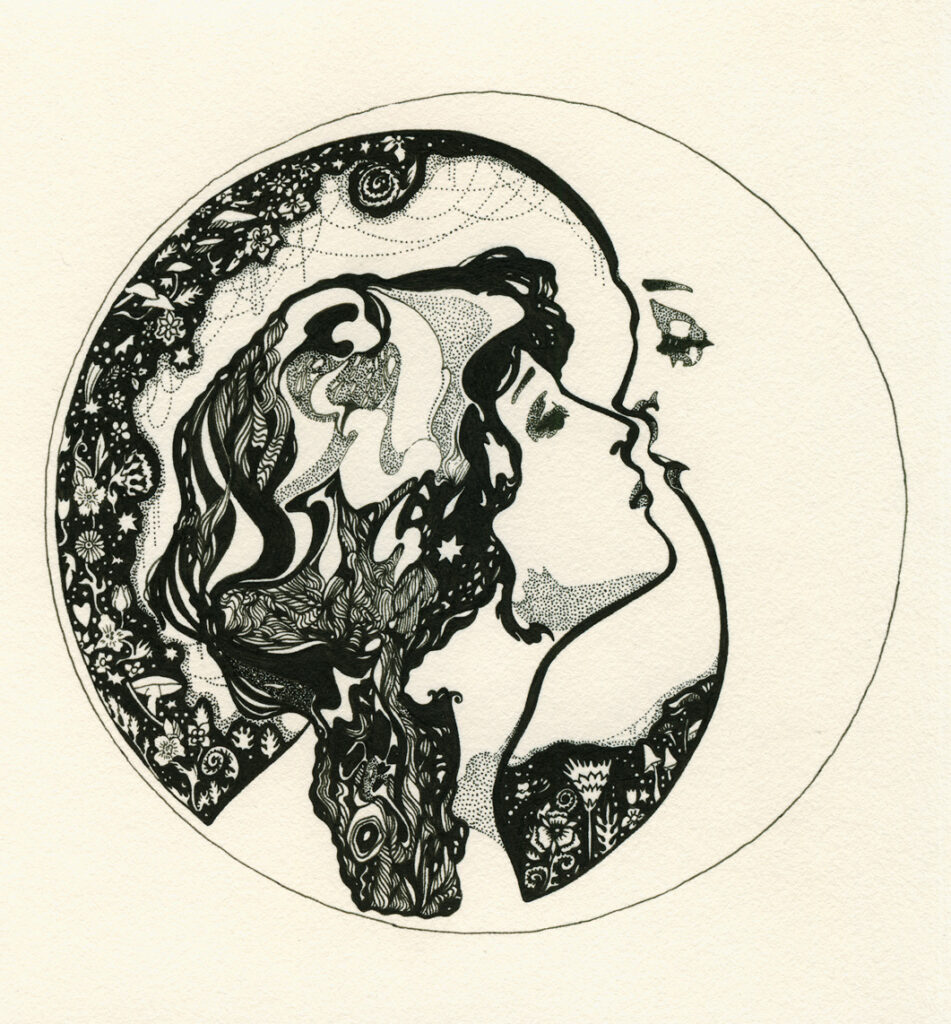
The Vivid Valley
Guest Stars in Texas City.
Strawberry Pop Tart.

Fig. It. Out.

The Vivid Valley
Guest Stars in Texas City.
Strawberry Pop Tart.
by Coco Quinn

The first thing I remember getting published was a poem I wrote in fifth grade for my elementary school’s anthology, “Tales from the Foot of the Volcano.” It was 1991 and I was living in Naples, Italy. I could see Mt. Vesuvius from my balcony, looking like two mountains next to each other as the crater into the active volcano was so wide and deep. When we hiked up to peer into that crater on a field trip our Italian teacher left the path dotted with holes from her high heels. I pictured her fashionable feet permanently arched like Barbie’s. I remember those tiny holes in the dirt along the path, but nothing of what we could see at its peak.
“Vesuvius is overdue to erupt,” I remember hearing. It had been dormant for many decades at that point. Any day now, and I could be frozen in ash like the people who’d been victim to it in Herculaneum, which had been another field trip destination.
It’s funny when you move a lot growing up. You’re subject to such a wide variety of impending natural disasters. Before Italy, I’d lived in Virginia Beach and Key West on the east coast. I had ten years under my belt of dealing with hurricanes. Fill the bathtubs with water, tape Xes over each window, and for a really big one, camp downstairs in the living room. In 1986, we got Hurricane Charley. I was seven with two little brothers and a baby sister. My dad was still out on a six-month cruise with the Navy. Charley knocked out the power. Mom set up a camping stove and battery powered black and white TV with a 5 inch screen. “The Peanut Butter Solution” aired during that time, and that movie was way more traumatic than the hurricane was. The day after the storm passed, we walked down the cul-de-sac, the sky fresh and blue, the air calm and lovely, just the pavement covered in leaves and branches, and the occasional car or rooftop dented in, to indicate how rough it had been out there.
Another thing about hurricanes, they give you a couple days warning. Not volcanoes, not tornados. I was home babysitting my sister in Mississippi (a truly culture-shock-inducing place to send a preteen girl after three years living in Italy), when I heard my first tornado. It sounds like a train. I hid us away in the tiny bathroom off of the kitchen, the only room in the house without windows, and felt like a sitting duck. The locals weren’t so bothered. My mom came home with my brothers from soccer practice, and even though the electric charge in the air had made my brother Jon’s hair stand on end, and the wind made accuracy in shooting impossible, their coach kept them on that field until practice time ended.
I spent twelve years in LA, and the earthquakes never made me panic. The wildfires though . . .
I’m in Virginia Beach now, and went into the ocean again for the first time in fifteen years. There were red flags up for “danger,” on the lifeguard stands. The water was frothy with riptides 50 feet out along the shore. The wind made it almost impossible to lay out a towel and I had to anchor mine with all my belongings, which were immediately covered in sand. Hurricane Ida hadn’t hit us directly, but I could feel her on the shore.
Even in the shallows, the waves crashed so hard I was soaked from head to toe right away. The usually even and sloping sand was impossible to see under the water and so pocked with holes that I sank under water from my knees up to my shoulders with a single step. I duck-dived under a wave. I floated and let the stormy waters push and pull me to and from the shore.
I laughed out loud as the tide bounced my butt into the sandy bottom as I tried to make my way back to the beach. I kept an eye on my coordinates by the lifeguard stand near where I’d left my towel. One of the very stands I’d worked from in summers during college. I didn’t know the guards who were working there today, nor they, me. But . . .
The Atlantic, she held me, rocked me, welcomed me home.

Tip Top No Typos
Flip Compact Powder Your Nose
All the News Fits Neat.
by KEM Huntley
The short story does not usually lend itself to a Dramatica Grand Argument. Moreover, there often is not enough “real estate” to properly explore all four throughlines. Nevertheless, it can be done. In answering key Dramatica questions, an analysis of James Thurber’s satire, The Catbird Seat, provides an example.
1. What is the title of the story?
The Catbird Seat
2. In a short paragraph, describe what The Catbird Seat is about.
This short story explored the horrors of “downsizing” long before the term became a fashionable catchword for the elimination of jobs and subsequent mass firings of loyal employees who often don’t see it coming. However, if you are one of those with an eye on the ball and few tricks up your buttoned-down shirt sleeve, you may just end up sitting pretty in the catbird seat.
3. Who is the author?
James Thurber
4. Where does the story take place?
New York, early 1940’s
5. Determine and describe the main character-the figure with whom the reader will most identify.
Mr. Erwin Martin: “Cautious, painstaking” (239)
6. Determine and describe the Impact Character-the figure that will have the most bearing on the main character.
Mrs. Ulgine Barrows: “Her quacking voice and braying laugh . . . . had appalled Mr. Martin instantly, but he hadn’t shown it. He had given her his dry hand, a look of studious concentration and a faint smile. ‘Well,’ she said, looking at the papers on his desk, ‘are you lifting the oxcart out of the ditch?’ Later: “The faults of the woman as a woman kept chattering on in his mind like an unruly witness. She had, for almost two years now, baited him. In the halls, in the elevator, even in his own office, into which she romped now and then like a circus horse, she was constantly shouting these silly questions at him. “. . . Are you tearing up the pea patch? Are you hollering down the rain barrel? Are you scraping around the bottom of the pickle barrel? Are you sitting in the catbird seat?’ . . . Mr. Martin dismissed all this with an effort. It had been annoying, it had driven him near to distraction, but he was too solid a man to be moved to murder by anything so childish.” (239-40)
7. Determine and describe all the characters concerned with the overall story.
8. At the end of the story, has the Main Character changed or remained the same (MC Resolve)?
Mr. Martin is steadfast in his drive to maintain his filing department and his position as its head.
9. Does the Main Character need to grow out of something (Stop) or grow into something (Start)?
Mr. Martin must stop the madness that is Mrs. Ulgine Barrows.
10. What is main character’s approach to solving problems? Does he at first confront a dilemma head-on (Do-er), or does he adapt himself to the situation at hand (Be-er)?
Although quiet and unassuming, Mr. Martin is nevertheless a do-er. Once Mr. Martin believes his department is Mrs. Ulgine Barrow’s next target he knows: “He must act quickly. . . . Mr. Martin stood up in his living room, still holding his milk glass. ‘Gentlemen of the jury,’ he said to himself, ‘I demand the death penalty for this horrible person'” (241).
11. Determine and describe the main character’s use of linear or holistic problem– solving techniques.
Mr. Martin uses linear thinking to solve his problems. Not only is his daily life extremely routine, his plan to “rub out” Mrs. Ulgine Barrows is done step by step.
12. Determine and describe the actions or decisions that drive the plot forward.
Actions drive the plot forward, first described in the backstory:
. . . Mrs. Barrows had met Mr. Fitweiler at a party, where she had rescued him from the embraces of a powerfully built drunken man who had mistaken the president of F & S for a famous retired Middle Western football coach. She had led him to a sofa and somehow worked upon him a monstrous magic (impact character domain-psychology). The aging gentleman had jumped to the conclusion (overall story symptom-deduction) there and then that this was a woman of singular attainments . . . . A week later he had introduced her into F & S as his special advisor (overall story response-induction). (240)
Later, Mrs. Barrows’ actions are the cause of Mr. Martin’s decision “to rub out Mrs. Ulgine Barrows. The term ‘rub out’ pleased him because it suggested nothing more that the correction of an error-in this case an error of Mr. Fitweiler” (239).
13. Determine and describe how the story has reached its conclusion (Story Limit). Is it because time has run out (Timelock), or because all the options (Optionlock) are exhausted?
Mr. Fitweiler has the option to either believe Mrs. Ulgine Barrows or Mr. Martin’s account of what had transpired between the two in determining which one will remain employed at F & S:
“Mrs. Barrows is under the delusion (impact character domain-psychology),” continued Mr. Fitweiler, “that you visited her last evening and behaved yourself in an-uh-unseemly manner.” He raised his hand to silence Mr. Martin’s little pained outcry. “It is the nature of these psychological diseases,” Mr. Fitweiler said, “to fix upon the least likely and most innocent party as the uh-source of persecution. These matters are not for the lay mind to grasp, Martin. I’ve just had my psychiatrist, Dr. Fitch, on the phone. He would not, of course, commit himself, but he made enough generalizations to substantiate my suspicions. I suggested to Mrs. Barrows, when she completed her-uh-story to me this morning, that she visit Dr. Fitch, for I suspected her condition at once. She flew, I regret to say, into a rage, and demanded-uh-requested that I call you on the carpet. You may not know, Martin, but Mrs. Barrows had planned a reorganization of your department-subject to my approval, of course, subject to my approval (main character problem-reduction). This brought you, rather than anyone else, to her mind-but again that is a phenomenon for Dr. Fitch and not for us. So, Martin, I am afraid Mrs. Barrows’ usefulness here is at an end.”
“I am dreadfully sorry, sir,” said Mr. Martin. (244-45)
14. Is the outcome of the story a Success or Failure?
This is a success story. Mrs. Ulgine’s dismissal from F & S means the potential (overall story solution) for more departmental reorganization, therefore disruptions, is eliminated.
15. At the end of the story does the Main character feel Good or Bad (Judgment)?
Mr. Martin, without having to literally “rub out” Mrs. Ulgine Barrows has still effectively removed his nemesis, thus relieving his angst:
“I regret that this has happened,” said Mr. Fitweiler. “I shall ask you to dismiss it from your mind, Martin.” “Yes, sir,” said Mr. Martin, anticipating his chief’s “That will be all” by moving to the door. “I will dismiss it.” He went out and shut the door, and his step was light and quick in the hall. When he entered his department he had slowed down to his customary gait, and he walked quietly across the room to the W20 file, wearing a look of studious concentration. (245-46)
16. Describe the four points of view (domains): Overall, Main Character, Impact Character, and Relationship.
17. What is the Goal of the story? Describe.
How the “system” of F & S stands (Present) is the story goal. Although the company president, Mr. Fitweiler, has hired Mrs. Ulgine Barrows “to bring out the best in him and in the firm” (240), “. . . in Mr. Martin’s mind . . . . Mrs. Ulgine Barrows stood charged with willful, blatant, and persistent attempts to destroy the efficiency and system of F & S” (240).
18. What thematic conflict in the Overall Story is explored?
The workplace of F & S, has been in an uproar since the “. . . day confusion got its foot in the door” in the arrival of Mrs. Ulgine Barrows. Her attempts at reorganization, with no prior professional experience, are depicted negatively, whereas those who are suited for the task at hand are shown in a positive light (work vs. attempt).
19. What is the problem in the Overall Story?
Mr. Fitweiler’s total reliability on Mrs. Ulgine Barrows’ judgment (certainty) creates problems for the employees of F & S:
After Miss Tyson, Mr. Brundage and Mr. Bartlett had been fired and Mr. Munson had taken his hat and stalked out, mailing in his resignation later, old Roberts had been emboldened to speak to Mr. Fitweiler. He mentioned that Mr. Munson’s department had been “a little disrupted” and hadn’t they perhaps better resume the old system there? Mr. Fitweiler had said certainly not. He had the greatest faith in Mrs. Barrows’ ideas (impact character concern-conceiving). (240)
20. Describe what conflict (Concern) occurs in the four throughlines.
21. Describe the sequence of events for the four throughlines (Signposts).
Overall story: In the past (Signpost 1) F & S was a staid, old firm operating quite efficiently, until the day:
[Mrs. Barrows’] . . . quacking voice and braying laugh had first profaned the halls of F & S on March 7, 1941. . . . It was competent, material, and relevant to review her advent and rise to power. Mr. Martin had got the story from Miss Paird, who seemed always able to find things out. . . . Mr. Martin came now, in his summing up, to the afternoon of Monday, November 2, 1942-just one week ago. On that day, at 3 P.M., Mrs. Barrows had bounced into his office. “Boo!” she had yelled. “Are you scraping around the bottom of the pickle barrel?” Mr. Martin had looked at her from under his green eyeshade, saying nothing. She had begun to wander about the office, taking it in with her great, popping eyes. “Do you really need all these filing cabinets?” she had demanded suddenly. (241) Much to Mr. Martin’s alarm, Mrs. Ulgine Barrows’ progress (Signpost 2) in turning F & S upside down includes the “reorganization” of his department. Mr. Martin shares his (phony) future (Signpost 3) plans with Mrs. Barrows that includes blowing up their boss. Once she reports his extremely out of character behavior to Mr. Fitweiler, her state of mind is questioned, and she is dismissed (Signpost 4-present). Mr. Martin is successful in stopping her from steam rolling his department and wreaking any further havoc at F& S.
Main Character: Mr. Martin bought the pack of Camels on Monday night in the most crowded cigar store on Broadway. It was theatre time and seven or eight were buying cigarettes. . . . If any of the staff at F & S had seen him buy the cigarettes, they would have been astonished, for it was generally known that Mr. Martin did not smoke, and never had (Signpost 1-obtaining). No one saw him. It was just a week to the day since Mr. Martin had decided to rub out Mrs. Ulgine Barrows. The term “rub out” pleased him because is suggested nothing more than the correction of an error-in this case an error of Mr. Fitweiler. . . . The project as he had worked it out was casual and bold, the risks were considerable. . . . And therein lay the cunning of his scheme. No one would ever see in it the cautious, painstaking hand of Erwin Martin, head of the filing department at F & S, of whom Mr. Fitweiler had once said, “Man is fallible, but Martin isn’t.” (239) Mr. Martin understands (Signpost 2) he must be very careful not to make any mistakes as: “If he ran into anybody, he would simply have to place the rubbing-out of Ulgine Barrows in the inactive file forever” (242). His plan is put into action (Signpost 3-doing) once he finds himself in her apartment: “Mr. Martin looked quickly around the living room for the weapon. He had counted on finding one there. There were andirons and a poker and something in a corner that looked like an Indian club. None of them would do. . . . When Mrs. Barrows reappeared, carrying two highballs, Mr. Martin standing there with his gloves on, became acutely conscious of the fantasy he had wrought. Cigarettes in his pocket, a drink prepared for him-it was all too grossly improbable. It was more than that; it was impossible. Somewhere in the back of his mind a vague idea stirred, sprouted. . . . The idea began to bloom, strange and wonderful. She put the glasses on a coffee table in front of a sofa and sat on the sofa. “Come over here, you odd little man,” she said. “Well,” she said, handing him his drink, “this is perfectly marvelous. You with a drink and a cigarette.” Mr. Martin puffed, not too awkwardly, and took a gulp of the highball. “I drink and smoke all the time,” he said. He clinked his glass against hers. “Here’s nuts to that old windbag, Fitweiler,” he said, and gulped again. The stuff tasted awful, but he made no grimace. “Really, Mr. Martin,” she said, her voice and posture changing, “you are insulting our employer.” (243) The following day, Mr. Martin learns (Signpost 4) his department will stay intact once Mr. Fitweiler deems Mrs. Barrows mentally incompetent, after she had reported a fantastic account of Mr. Martin’s evening visit.
Impact Character: Mrs. Barrows and her big ideas (Signpost 1-conceiving) are upsetting the apple cart at F & S. Her role (Signpost 2-being) as special advisor to the president has a profoundly negative effect on the company, and particularly on Mr. Martin. She comes dangerously close to becoming (Signpost 3) a corpse at Mr. Martin’s hands-but it is her self-righteousness that finally does her in. The concept (Signpost 4) that “such a drab, ordinary little man” (245) as Mr. Martin could cause her demise changes (impact character resolve) her from the office tyrant to a blithering idiot:
She stopped yelling to catch her breath and a new glint came into her popping eyes. . . . She glared at Mr. Fitweiler. “Can’t you see how he has tricked us, you old fool? Can’t you see his little game?” But Mr. Fitweiler had been surreptitiously pushing all the buttons under the top of his desk and employees of F & S began pouring into the room. “Stockton,” said Mr. Fitweiler, “you and Fishbein will take Mrs. Barrows to her home. Mrs. Powell, you will go with them.” Stockton, who had played a little football in high school, blocked Mrs. Barrows as she made for Mr. Martin. It took him and Fishbein together to force her out of the door into the hall, crowded with stenographers and office boys. She was still screaming imprecations at Mr. Martin, tangled and contradictory imprecations. (245)
Relationship Story: Whereas Mrs. Ulgine Barrows doesn’t give Mr. Martin a second thought (Signpost 1-conscious), Mr. Martin is very conscious of her threat to his department. He recalls (Signpost 2-memory) the description of her “ducky first-floor apartment” (242) as he makes his way to surprise her at home:
“‘Well, for God’s sake, look who’s here!’ bawled Mrs. Barrows, and her braying laugh rang out like the report of a shotgun. He rushed past her like a football tackle, bumping her. . . . ‘What’s after you?’ she said. ‘You’re as jumpy as a goat (Signpost 3-preconscious)'” (242). Instead of bumping Mrs. Barrows off, Mr. Martin acts out of character, fully cognizant that she will be driven to report his odd behaviour to Mr. Fitweiler the next day. She does, and to her great fury (Signpost 4-subconscious), finds Mr. Fitweiler thinks she’s crazy and her employment is terminated-much to the satisfaction of Mr. Martin.
Source Cited:
Thurber, James. “The Catbird Seat.” Studies in the Short Story. Ed. Adrian H. Jaffe and Virgil Scott. 3rd ed. New York: Holt, 1968. 239-246.
“. . . body’s catching up
to where I’ve already been
in my head.” Bravo.

What? The Dickens? Yo!
NoHo. More Shakespeare than Glee.
It’s Something to Sea.


by KEM Huntley
This ’70s joyride through LaLa Land’s exotic erotic film scene is a fresh twist on the extended family and the curious ties that bind. Writer/Director Paul Thomas Anderson presents a story that coolly dismisses accepted societal standards. He populates his screenplay with empty souls who follow their own (a)moral code, yet instead of alienating the audience, he convinces it to care.
A key component of this success is its underlying story structure. An exact storyform, however, is not immediately evidenced. At times it feels like an overall story with a goal of obtaining—the characters all want something: sex, drugs, fame and fortune. Other times the goal appears to be being—the characters believe their lifestyle is temporary and want to take on another role. Buck dreams of being his own boss—ruling the “Super Cool Stereo World.” Following the grand argument may be somewhat difficult when the plot progression falters, for example, after Dirk Diggler (main character) and Jack Horner’s (influence character) falling out, the relationship story steps aside for a considerable amount of screen time in favor of the other three throughlines. Still and all, dressed in its best polyester double knit, Boogie Nights turns story into film art as the acting, cinematography, soundtrack, and so forth spins you through its disco party.
What follows is one “rolleroid” snapshot perspective of this Goodfellasesque epic:
Pornographic film director Jack Horner opens the door to his private paradise as the setting for the overall story. “It resembles the Jungle Room at Graceland” and comes complete with Jacuzzi, swimming pool, and its own (basement) film studio. Talent resides at this secure (thematic issue) funhouse where reality is distorted by white lines and Cuervo Gold. It is here where the changing industry (story goal of progress) is debated:
FLOYD
The video revolution is upon us—and our role is critical.
COLONEL
Jack, please understand that this is not an argument . . . this is a fact (overall story catalyst).
JACK
What?
COLONEL
I think that there is a serious case to be made for the price and the gamble on the whole idea of a home video market . . . two, three years from now, everyone’s gonna be able to walk into their local supermarket and buy or rent a videocassette . . . film is just too damn expensive . . . the theaters are already planning converting to video projectors.
Jack represents a different way of thinking. He has the ability (thematic issue) to direct “stellar, sexual standouts” but his true desire (thematic counterpoint) lies in making porno films with “stories.” Jack discovers (story driver–action) the next big thing, Dirk’s big thang, and the relationship story throughline sets in motion as each takes a fixed position on what it means to be a director and an actor. The thematic issue of confidence illustrates the positive aspects of their relationship. Jack is certain of Dirk’s value (relationship story catalyst), and this assuredness plays out–making the director amenable to the kid’s ideas—his own stage name and his own action series (Brock Landers: Angels Live in my Town).
Sweet-natured and trusting (main character symptom), Dirk is a physics character, whose first approach to a problem is to work it out externally (doer). His male mental sex has led him to an environment where he can be “a big, bright, shining star.” An inexperienced (thematic counterpoint) actor, Dirk’s raw skills (thematic issue) are applauded in the adult film world (“Diggler delivers a performance (doing) worth a thousand hard-ons”).
The relationship story concern is explored in the preconscious, where Dirk’s anywhere, anytime, sexual impulses (“I can do it again if you need a close-up”) are filmed under the direction of Jack. The fantasy world Jack fabricates for Dirk eventually inhibits their relationship. Dirk boasts he blocks his own sex shots “. . . and he (Jack) gives me flexibility to work with the character . . .” His vanity pricked, Jack laughs it off.
Jack’s tolerance (problem of accurate) of Dirk’s escalating ego and cocaine habit reaches its limit, illustrated when Dirk, strung out, screams, “YOU’RE NOT THE BOSS OF ME!” (solution of non-accurate) and Jack immediately fires him (overall story consequence of preconscious).
Anderson deftly indicates how the effects of the objective characters’ individual circumstances create dilemmas for them: the effect Amber Waves’ career choice has on her custody battle (no visiting rights), the effect Little Bill’s wife’s flagrant sexual escapades have on her husband (murder in cold blood), and particularly, the devastating effect Dirk has on Scotty (heart wrenching humiliation).
For Dirk, doing the hustle no longer means choreographed booty shakes—it’s risky street business with ill effects (main character problem). Trapped in a nightmarish parody of his own action films (Guns! Firecrackers! Sister Christian!) Dirk finally realizes he has no other option but to stop his wayward Wonderland course—that only he can be the agent (cause) of his change—a solution shared in the overall story.
Stripped of his pride, a wiser (unique ability) Dirk stumbles back to his Hollywood home. By this time, Jack has resolved his own problem of sticking to the proven method of producing porno on film to successfully using videotape (unproven). Preparing for his next feature with Jack, Dirk’s angst has evaporated (story judgment good). He is cool. He is sexy. He chants to his mirror image—“I’m a star, I’m a star, I’m a star, I’m a star, I’m a star, I’m a big bright shining star”—and karate kicks to the credits.
by KE Monahan Huntley
Pecker is a Dramatica grand argument story emanating from John Waters’ weird, yet very real, world. Pecker (main character) is a “snappy go happy—happy go lucky” amateur photographer. His sidekick, and occasional assistant, Matt, is a pro at “five-finger discounts.”
PECKER
Dude, you’re gonna get popped.
MATT
Not me bro—I’m invisible.
Pecker’s girlfriend, Shelley the “stain goddess” (influence character), operates the local laundromat—The Spin n’ Grin.
PECKER
You’re my Venus De Milo.
SHELLEY
You’re crazy. You see art when there’s nothing there.
Pecker’s parents run business ventures that run in the red. His mother’s thrift store outfits the homeless; his father’s dive bar cannot compete with the strip club (overall story focus-temptation) across the way. Little sister Little Chrissy is a sugar maven; big haired big sister Tina bartends at the downtown gay discotheque. Grandmother Memama has a roadside pit beef (!) sandwich stand, and believes her Blessed Mary statue speaks (overall story solution-faith).
Pecker is open (main character unique ability) to the variety of life in and outside of Hampden, a district of Baltimore: “If it wasn’t for you, Peckerman, I’d never know this shit existed.”
To Pecker, “everything always look good” through the lens of his camera.
Pecker has taken pictures all over Baltimore for his first exhibit to be held at the fast-food joint where he works, The Sub Pit.
The fliers he has plastered around town (main character approach-doer) catch the eye of Rorey. She approaches (overall story catalyst) Pecker, checkbook in hand: “Your pictures are amazing. They’re the real thing. . . . I’d love to give you a show in my New York Gallery—if you’d be willing.”
At the opening, Pecker and his “culturally challenged family” are introduced to the New York art world that anoint him: “A brand new art star.” Pecker snaps pics of the chic crowd because: “Life is nothing if you’re not obsessed.”
The family returns to Hampden to find their home burglarized. Rorey encourages him to: “Take pictures, Pecker. This could be your next show. Your dad’s loss. Your mom’s sadness. Get close-ups.” As quickly as the community has embraced Pecker’s fame, they are ready to disown it—and him. The police officer investigating the case admonishes the boy: “What they call art up in New York young man, looks like just plain misery to me.” Shelley entreats him not to: “. . . become (consequence) an asshole, Pecker. I beg of you, do not become an asshole.”
All manners of catastrophes hit. Little Chrissy is put on Ritalin. Matt is caught shoplifting. Tina’s fired. Memama is accused of faking Mary’s miracle. Pecker can no longer take original photos: “I’m trying to get new stuff, but everyone knows me now.” As one potential snapshot subject snaps: “Some people don’t feel like being art.”
When Rorey puts the moves on Pecker (main character focus-temptation), an act witnessed by Shelley—it is the last straw for the photographer (main character response-conscience). Assuring Shelley he loves her “more than Kodak” (relationship story thematic counterpoint-commitment) he turns his back on New York and says: “They can come to me this time . . . I’m going to have my own show right here in Baltimore (mental sex-female).”
Shelley learns (overall story requirement) to appreciate the colors of her world (influence character resolve-change), and the town realizes its favorite son is true blue (main character resolve-steadfast). New York travels to Baltimore by limousine, and Pecker’s “outsider art” is a brilliant success (overall story outcome). All applause for Pecker and “the end of irony.” A newscaster inquires, “So what’s next, Pecker?” To which he replies, “Well. I’m thinking of directing a movie.” (main character concern-future)